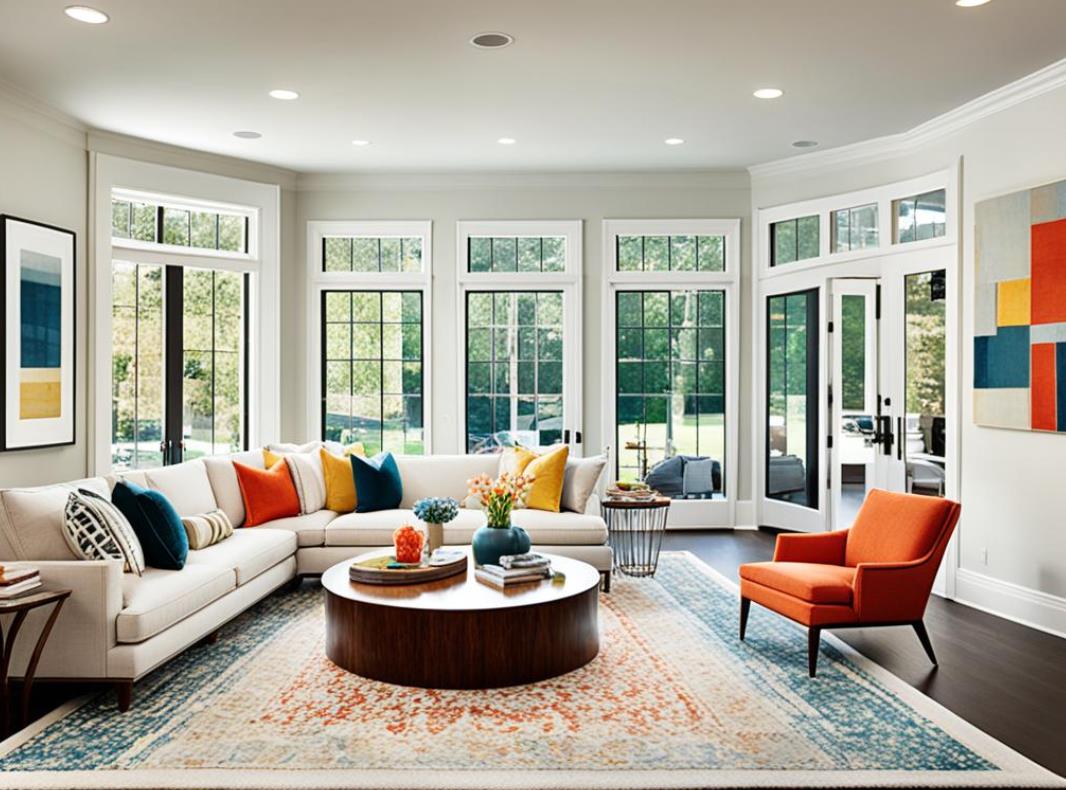Are you struggling to figure out the perfect way to place a rug in your living room? Do you find yourself unsure of where to place it, how to position it, or even what size rug is right for your space? If so, you’ve come to the right place! In this article, we will guide you through the art of rug placement in a living room. Whether you’re looking for a cozy, inviting feel or a more modern, sleek aesthetic, we’ve got you covered. With our rug placement tips, dos and don’ts, and 12 best ways to place a rug, you’ll soon be able to transform your living room into a stylish and comfortable haven. So, let’s dive in and discover how to place a rug in a living room like a pro!
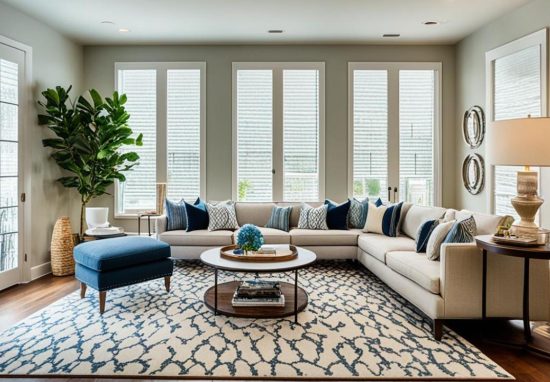
The way you position a rug is more than just laying it down. It’s about creating a vibe. Tips for rug placement are like tools for decorating a canvas. With my favorite methods, I aim to boost the look and use of your space. I want your living room to look and feel like a beautiful symphony.
First up, it’s crucial to measure your space and rug size carefully. The right size makes all the difference. Next, think about the rug’s shape and texture. They should work well, not fight. Then, I make sure my pick adds to the room’s charm without sticking out. For techniques four through twelve, I’m going to show you some clever yet doable ways to position your rug just right. Stick around to learn all the best rug placement techniques.
What are the Basics of Rug Placement?
Have you thought about how a simple rug could change your living room’s look completely? I truly believe that small details make big differences. So I’ve focused on solving the “how to place a rug in a living room” puzzle. I’m here to share the best 12 ways to make your rug stand out in style and comfort.
Starting to improve your living room begins with knowing how to place a rug right. The right rug can make your room look good and organize the space. I’ll show you some key points to picking the best rug for your living room.
Rug Size Guide for Living Rooms
Choosing the right rug size is a big part of making your living room look good. You have to factor in how the rug fits with your furniture and room size. For a small living space, a 5′ x 8′ rug might be enough. For bigger rooms, an 8′ x 10′ would work better. This ensures your key furniture can rest on the rug nicely.
The Importance of Rug Positioning in a Room
Where you place your rug really matters for how your room looks and feels. The right placement can make your seating areas clear and improve how the room flows and feels. A rug can make a spot for your furniture or separate a dining area, changing how lively the room is.
Selecting the Right Rug Shape and Texture
The shape and feel of your rug are as important as the size. A rectangular rug is good for most living rooms. But, a circular or oval one might be better if you have special furniture or want to soften sharp room angles. A soft, plush rug can make a room cozy and warm, perfect for places your family spends a lot of time. On the other hand, a flat-weave rug can handle more use, making it great for rooms that get a lot of traffic.
How to Place a Rug in a Living Room; 12 Best ways
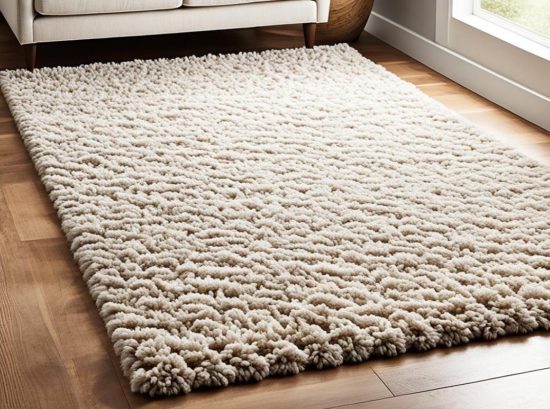
My journey through interior design taught me a lot. A well-placed rug can really change a living room. I’ll share the top twelve rug placement techniques that mix looks with purpose. They make your living room bette
1. Center the rug under the main coffee table
Placing the rug centrally under the coffee table creates a tidy appearance and anchors the room’s decor. This method ensures that the rug acts as a foundation for the coffee table, aligning with the room’s symmetry.
By centering the rug, you enhance the visual balance, making the space feel more organized and intentional. It also helps to define the seating area, making the space more inviting. The rug’s position in relation to the coffee table can dictate the flow and feel of the entire room, making this a crucial setup step.
2. Ensure coverage for seating areas
A rug that extends under all the seating furniture connects the pieces and unifies the space. It’s important that the rug is large enough to accommodate at least the front legs of sofas and chairs. This creates a cohesive look and makes the seating area more comfortable and grounded.
A well-sized rug also helps to minimize noise and echo, adding a layer of acoustic comfort. Ensuring coverage for seating areas prevents the furniture from feeling disjointed, promoting an inviting atmosphere. This approach also helps define the boundaries of different functional zones within the room.
3. Use multiple rugs to define spaces
In larger living rooms, using multiple rugs can effectively delineate different areas, such as a reading nook or a dining section within the space. This strategy allows for the creation of mini-environments, each with a distinct feel yet tied together by style or color.
Multiple rugs can also add layers of texture and color, enhancing the overall aesthetic of the room. This approach is especially useful in open-plan spaces where furniture alone might not be enough to visually divide the area. Careful placement of rugs ensures that each section feels purposeful and independently functional. Additionally, varying rug styles can add dynamism and visual interest to the room.
4. Align with the room’s focal point
Positioning your rug to complement the main focal point, such as a fireplace or a prominent piece of art, enhances the room’s layout. This alignment not only draws attention to the focal point but also harmonizes the room’s decorative elements. The rug should help guide the eye towards the central feature, reinforcing its significance.
This method can be particularly effective in rooms where the focal point dictates the arrangement of furniture. By aligning the rug with this feature, you enhance the architectural and decorative elements of the space. It’s also a way to create a sense of luxury and emphasis in the room, making the focal point stand out even more.
5. Opt for a textured rug to add depth
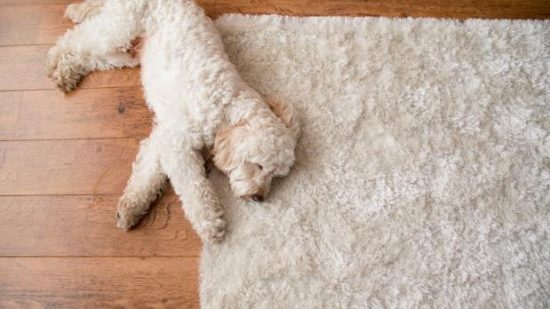
A textured rug introduces a tactile element that can make a living room feel warmer and more inviting. Textures such as shag, sisal, or woven designs add visual interest and can contrast nicely with smooth surfaces like leather or wood. Textured rugs are particularly useful in monochromatic color schemes, where they add depth and prevent the space from looking flat.
They also help to hide dirt and wear, making them practical choices for high-traffic areas. By choosing a textured rug, you can layer in coziness and make the room feel richer and more lived-in. This choice also helps to soften the overall aesthetic of the space, making it more welcoming.
6. Leave adequate border flooring
Leaving a border of exposed flooring around the rug frames the space and can make the room appear larger. This border ensures that the rug doesn’t overwhelm the room but rather complements it. The exposed flooring can also highlight the beauty of the material, whether it’s hardwood, tile, or another finish.
A well-proportioned border helps to balance the room’s elements, providing breathing room between the rug and the walls. This technique also allows for easier cleaning and maintenance around the edges of the room. Ensuring that the rug is properly scaled with a surrounding border can make the space feel more open and less cluttered.
7. Consider the room’s traffic
Choosing a durable rug for high-traffic areas ensures that it remains visually appealing and functional over time. High-traffic areas benefit from materials like wool or synthetic fibers that can withstand wear and tear. It’s important to consider not just the aesthetics but also the practicality of the rug material in areas where foot traffic is heavy.
A durable rug also requires less frequent replacement, making it a cost-effective choice. Additionally, darker colors or patterns can help mask dirt and stains that come with regular use. This consideration keeps your living space looking neat and well-maintained, enhancing the overall comfort and longevity of the rug.
8. Layer rugs for a trendy look
Layering a larger, neutral rug with smaller, colorful or patterned rugs can add depth and interest to a room. This approach allows for flexibility in updating the look of the room with minimal effort—simply swap out the top layer for a different style. Layering rugs also offers the opportunity to mix textures and colors, adding richness to the decor.
It can define or redefine spaces within a room without major furniture rearrangements. This trendy technique is not only stylish but also practical, providing extra cushioning and warmth. Layered rugs can also help anchor furniture groupings, creating distinct zones within a larger space.
9. Synchronize with room color schemes
Selecting a rug that harmonizes with the existing color scheme ties the room’s elements together. This synchronization can enhance the overall cohesiveness and flow of the space. When choosing a rug, consider both the dominant and accent colors of the room to ensure that it complements rather than clashes with the existing décor.
A well-chosen rug can act as a focal point or as a subtle background that enhances other features. It’s also an opportunity to introduce new textures and patterns that complement the room’s color palette, adding layers of visual interest. This method ensures that the rug contributes positively to the aesthetic harmony of the space.
10. Choose the shape based on furniture layout
Selecting a rug shape that complements the furniture can enhance the overall look and flow of the room. For instance, a round or oval rug can soften the appearance of a room with predominantly angular furniture. This choice can also help break up the monotony of straight lines and right angles, providing a visually appealing contrast.
The rug shape should also facilitate the arrangement of furniture, encouraging a natural flow of movement within the space. Whether it’s a rectangular, round, or custom-shaped rug, it should serve to frame the furniture effectively, making the room feel more organized and thoughtfully designed.
11. Adjust rug placement with seasons
Changing rugs according to the seasons can refresh the look of a room and make it feel more comfortable year-round. Lighter, thinner rugs are ideal for spring and summer, offering a cooler, airier feel, while thicker, denser rugs are cozy for fall and winter.
This adjustment can also be an opportunity to bring seasonal colors and patterns into the room, enhancing the mood and reflecting the time of year. Seasonal changes to decor, such as rug swapping, can be a fun and creative way to keep your living space feeling current and inviting. It also extends the life of your rugs by reducing wear.
12. Experiment with orientation
Trying different orientations and positions for the rug can dramatically change the perception of space in a room. This experimentation can help you discover the most visually pleasing and functional arrangement for your living space. Whether it’s aligning the rug with a certain piece of furniture or angling it to direct traffic flow, small adjustments can make a big difference. This flexibility allows for customization of the space according to changing needs or preferences. Experimenting with rug orientation is a simple yet effective way to refresh a room’s look without significant investment or effort.
When placing rugs, remember they should look good but also be useful. A well-placed rug makes your room’s design better and the room more comfy and practical.
Maximizing Your Space with Strategic Rug Placement
Rug placement can totally change a room’s vibe, even if it’s small. By using rug layout suggestions, you’ll boost your room’s look and its use. This is how rug positioning in a room can make everything feel cozy and well-balanced.
Rug Layout Suggestions for Small and Large Rooms
Dealing with a small space? Pick light color rugs and simple patterns. They’ll make your room seem bigger and match any style. This makes your room feel spacious and welcoming.
In bigger rooms, choose a rug that fits your furniture well. It shouldn’t be too small or too big. This way, your rug will help divide the room into sections, like a cozy book nook or a dining space. It adds both style and coziness to big areas.
Incorporating Rugs into Open Floor Plans
Open layouts need rugs to define where one area ends and another begins. This helps your space look together without using walls. Choosing the right rug can bring unity to your living, dining, and relaxing spots.
Strategic rug placement works wonders in both big lofts and tiny studios. It’s not just about the decor. It’s how you position your pieces that really brings a room to life. Remember, balance and harmony are key for an amazing space.
Accentuating Furniture with Proper Rug Placement
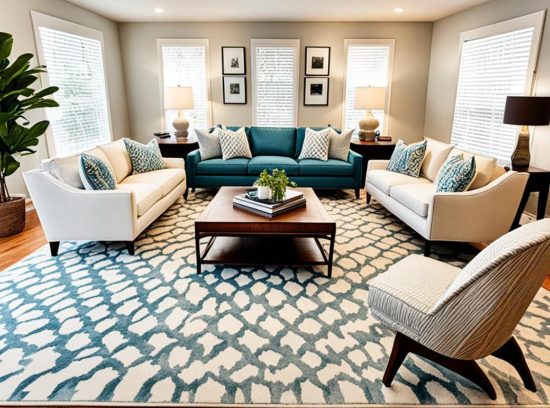
I’ve seen many living rooms change just by how rugs are placed. The right best rug placement techniques add beauty and function to a room. To master rug arrangement ideas, you must balance where you put the rug. Placing it under furniture can make your space feel cozy and pull everything together. However, it’s crucial to do this with care.
Let’s talk about the best ways to position rugs for big impact. No matter if you have a big sofa, a dainty settee, or many chairs and sofas, where you put the rug matters a lot.
- All legs on the rug: This makes a room look put together and welcoming, especially in bigger spaces or specific seating areas.
- Front legs only: If you want a more open feel, this way connects the furniture with the rug but keeps the room feeling spacious.
When using these rug arrangement ideas, remember that the size and fit of the rug are critical. It should be big enough for your furniture without looking too crowded. With the best rug placement techniques, a rug becomes an essential part of your room, helping with both look and function.
To wrap up, placing a rug under furniture is all about mixing accuracy with flair. A rug does more than cover the floor. It changes how we use and enjoy the rooms in our homes. So, choose well, and see how a rug can turn a room from basic to beautiful.
Rug Placement Dos and Don’ts
Learning how to place rugs can make your living room look and feel better. It’s important for both experienced decorators and beginners. You need to know the best ways to make your space look great with rugs. Let’s explore some important tips and mistakes to avoid. This will help you place your rugs in a way that shows off your style and is practical.
Placing a Rug Under Furniture: Guidelines
Putting a rug under furniture is a great way to tie a room together. It gives a room a clear area without making it feel small. To do this well:
- Make sure the rug is big enough for all your furniture. The front legs of sofas and chairs should be on the rug. This keeps everything looking like it belongs together.
- Avoid putting your rug right against the walls. A little space between the rug and the wall makes the room seem bigger.
This technique keeps your room from looking messy or like something’s missing. By seeing some floor around the rug, your room looks more organized.
Avoiding Common Rug Placement Mistakes
Knowing what mistakes to avoid is as crucial as knowing what to do right. Bad rug placement can ruin a room’s look and function. Here is what to watch out for:
- Don’t pick a rug that’s too small. It can make the space seem unbalanced. Your rug should match the room’s size and layout.
- Don’t forget to look at the room’s color and style when choosing a rug. The rug should fit in with the room’s look. Think about the rug’s color, design, and feel before you buy it.
Placing rugs is more than making a room look pretty. It’s about making the room more useful and inviting. Following these dos and don’ts can help you make a space that’s appealing and comfy. This advice can help anyone, seasoned or new, make their living room look better.
Conclusion
My journey through learning about rug placement taught me how rugs help show our style. By showing you twelve ways to put a rug in your living room, I’ve helped you make your home stylish and cozy. The real secret is not just picking the rug, but where and how you place it. It’s about making the room look and feel just right.
Choosing the right size rug for your room’s furniture and placing it skillfully can really change a space. These tips help you make the most of your living room, making it look beautiful and welcoming. The best part is when everything matches up; your room will feel like it all belongs together beautifully.
In ending, I shared twelve ways rugs can make your living space better. Placing a rug is important and takes some thinking. With these tips, you can choose and position your rug to improve your room. I hope this guide helps you create a living room that truly reflects who you are, stylish and welcoming.
FAQs on Placing a Rug in a Living Room
What are the best ways to place a rug in a living room?
Placing your rug can be done in several ways. You might center it under the main coffee table. This can be a good start. Then make sure all your seats are on the rug to connect the space. If your room is big, you can use more than one rug. This can help create different sections. Remember to think about the rug’s size, shape, and how it feels. This will make your room look good and work well.
How do I choose the right size rug for my living room?
Picking the right rug size is key in your living room. Look at your room’s size and how you have your furniture. Think about where people walk a lot. It’s good to choose a rug that lets some floor show around it. But it should still be big enough for your main sitting area.
Why is rug positioning in a room important?
Rug positioning is key for a few reasons. It marks off different areas and makes your space flow better. This helps your room seem bigger, all tied together, and comfy. A well-placed rug can really change how a room feels.
Should a rug be placed under furniture in a living room?
Having a rug under your furniture is usually a good idea. It ties your sitting area together. You can put all the furniture legs on the rug or just the front legs. Just be sure you can see some rug past your furniture.

